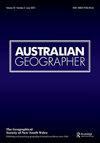定位与调整:澳大利亚布里斯班-米恩金的行走、漫游与寻路探索
IF 2
2区 社会学
Q2 GEOGRAPHY
引用次数: 2
摘要
摘要本文探讨了我们在行走、漫游和寻路时,在定位、调整和创建新轨迹的方式上的差异。根据在布里斯班-Meanjin的市中心步行道上一起或分开行走的生活体验,我们对计划外运动、自发性和流动的情感记录之间的关系进行了概念性探索。在讨论我们走路的具体一瞥和描述,以及这种情况转变为“徘徊”的时刻时,我们反思徘徊的情节,认为它不仅仅是有目的的走路,或者不同于有目的的散步。这些都是复杂的动觉、视觉记录、想象、推测和预期过程,对寻路设计的感官线索做出反应。我们认为,漫游创造了意想不到的轨迹,在将自己从方向上解开的过程中,以不同的方式定位和调整运动,同时从城市空间中抽象且往往丰富多彩的寻路和机动性设计中获得灵感。作为一种概念干预,这些曲折反映了跨流动性、创造性方法和地理研究的研究,作为一种研究工具,而不是方法论修正。我们考虑运动在城市景观中的作用,以及我们在寻路和机动性设计中遇到的问题。本文章由计算机程序翻译,如有差异,请以英文原文为准。
On orientations and adjustments: an exploration of walking, wandering and wayfinding in Brisbane – Meanjin, Australia
ABSTRACT This paper explores the differences in the ways we orientate, adjust and create new trajectories as we walk, wander and wayfind. Drawing on lived experiences of walking together and separately through inner-city walking paths in Brisbane – Meanjin, we offer a conceptual exploration of the relationship of unplanned movement, spontaneity and affective registers of mobility. Discussing specific glimpses and accounts of our walking, and moments where this drifts into ‘wandering’, we reflect on the episodes of wandering as something more than, or different to, purposeful walking. These are complex processes of kinaesthetic, visual registers, imagination, conjecture and anticipation, responding to sensory cues from wayfinding design. We suggest that wandering creates unanticipated trajectories that orientate and adjust movements differentially in untying itself from direction, simultaneously taking inspiration from the abstracted and often colourful wayfinding and mobilities designs that feature in urban spaces. As a conceptual intervention, these meanderings reflect on research across mobilities, creative methods and geographical research, as a tool for doing research rather than methodological revision. We consider the role of movement in urban landscapes and the encounters we have with wayfinding and mobilities design.
求助全文
通过发布文献求助,成功后即可免费获取论文全文。
去求助
来源期刊

Australian Geographer
GEOGRAPHY-
CiteScore
4.10
自引率
8.30%
发文量
33
期刊介绍:
Australian Geographer was founded in 1928 and is the nation"s oldest geographical journal. It is a high standard, refereed general geography journal covering all aspects of the discipline, both human and physical. While papers concerning any aspect of geography are considered for publication, the journal focuses primarily on two areas of research: •Australia and its world region, including developments, issues and policies in Australia, the western Pacific, the Indian Ocean, Asia and Antarctica. •Environmental studies, particularly the biophysical environment and human interaction with it.
 求助内容:
求助内容: 应助结果提醒方式:
应助结果提醒方式:


